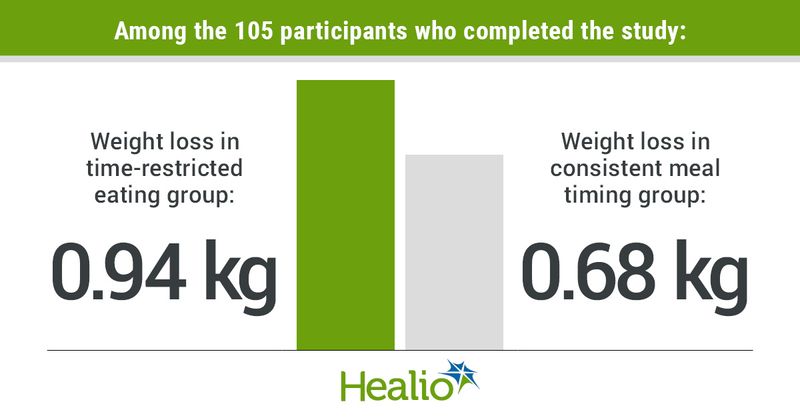Study results challenge effectiveness of intermittent fasting protocol
Individuals engaged in time-restricted eating without any other intervention did not lose significantly more weight than individuals who ate throughout the day, a randomized clinical trial showed.
Time-restricted eating is a protocol of the popular intermittent fasting program, according to Dylan A. Lowe, PhD, of the Cardiovascular Research Institute at the University of California, San Francisco, and colleagues.

Lowe and colleagues randomly assigned 116 adults with BMIs of between 27 kg/m2 and 43 kg/m2 (mean age, 46.5 years; 70 men) in an approximate 1:1 ratio to follow either a time-restricted eating (TRE) plan or a consistent meal timing (CMT) plan. The TRE cohort ate whatever they wanted for 8 hours and then fasted from caloric foods and beverages for 16 hours. The CMT cohort ate three structured meals daily and, if they chose, snacks between meals. Both groups received guidance on the timing of their food intake. All participants also received an app with food plan reminders, a Bluetooth scale connected to the app that allowed researchers to track users’ weight loss and a $50 Visa gift card for participating.
Researchers reported that among the 105 participants who completed the 12-week trial, there was a significant weight loss in the TRE group (–0.94 kg; 95% CI, –1.68 to –0.2) and a nonsignificant weight loss in the CMT group (–0.68 kg; 95% CI, –1.41 to 0.05). However, there was no significant difference in weight loss between the groups (–0.26 kg; 95% CI, –1.3 to 0.78).
Among a subset of 46 participants (CMT followers, 24) who volunteered for in-person metabolic testing, there was a significant within-group decrease in weight among the TRE cohort (–1.70 kg; 95% CI, –2.56 to –0.83) and appendicular lean mass index (–0.16 kg/m2; 95% CI, –0.27 to –0.05). There were no significant changes in estimated energy intake, fasting glucose, fasting insulin, fat mass, HbA1c, resting energy expenditure and total energy expenditure within the two groups.
“Together, the results of this study one, do not support the efficacy of time-restricted eating for weight loss; two, highlight the importance of control interventions; and three, offer caution about the potential effects of time-restricted eating on appendicular lean mass,” Lowe and colleagues wrote, adding that future research should examine how early vs. late time-restricted eating and protein intake or timing may neutralize appendicular lean mass losses.

